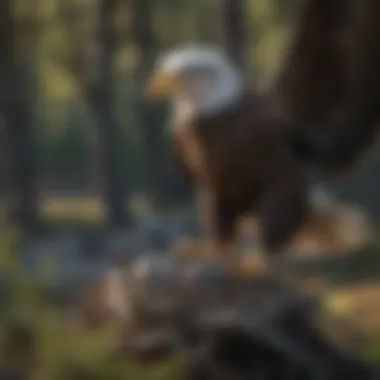Unveiling the Enigmatic Bald Eagle: A Comprehensive Exploration


Nature Topic Overview
Fun Facts and Trivia
Eager young minds will be enthralled to discover that the bald eagle is not actually bald but derives its name from the Old English word 'balde,' meaning white. Additionally, these birds of prey have incredible vision, enabling them to spot fish in the water from high above the sky. Engaging visuals and interactive elements will enrich young readers' learning experience, fostering a deeper appreciation for the beauty and prowess of these magnificent creatures.
Wildlife Explorations
Within the realm of bald eagles, it is essential to also explore their habitat and the diverse species that coexist alongside them. From the towering coniferous forests to the serene lakes where they hunt for fish, bald eagles are intricately connected to their environment. Delve into quizzes and puzzles that challenge young minds to understand the intricate relationships between animals and plants in the bald eagle's habitat.
Environmental Awareness
Understanding the importance of conservation and sustainability is paramount when discussing the bald eagle. Children can play a vital role in protecting these regal birds by learning about the impact of pollution and deforestation on their natural habitat. Simple tips on recycling, reducing waste, and preserving wildlife habitats empower young readers to become stewards of the environment, ensuring the continued existence of the bald eagle and other endangered species.
DIY Nature Activities
Encourage children to immerse themselves in nature through hands-on activities and creative projects inspired by the bald eagle. Step-by-step guides for crafting symbolic eagle feathers or building miniature nests provide an exciting way for children to connect with these magnificent creatures. Outdoor explorations, such as bird-watching excursions or nature scavenger hunts, offer practical opportunities for kids to apply their newfound knowledge and foster a deep love for the natural world.
Introduction to the Bald Eagle
The bald eagle, with its striking appearance and impressive hunting prowess, holds a significant place in the ecosystem and cultural narratives. This section serves as a foundational exploration of the bald eagle, covering its physical traits, habitats, behaviors, conservation status, and cultural significance. By understanding the essence of the bald eagle, we gain valuable insights into the natural world and human perceptions of this magnificent bird.
Physical Appearance
Notable Features
The notable features of the bald eagle, such as its sharp beak, keen eyesight, and formidable talons, set it apart as a top predator in its environment. These traits contribute to the eagle's success in hunting and offer a glimpse into the evolutionary adaptations that make it a formidable aerial hunter. Their distinctive features showcase the adaptability and efficiency of the bald eagle in its habitat, making it a subject of admiration and study among researchers and wildlife enthusiasts.
Distinctive Plumage
The distinctive plumage of the bald eagle, with its striking contrast between the white head and tail feathers and dark brown body, serves multiple purposes. It provides camouflage during hunting expeditions while also serving as a visual representation of power and grace. The unique coloration of the bald eagle's plumage plays a crucial role in its survival and reproduction, marking it as a symbol of natural beauty and resilience.
Size and Wingspan
The size and wingspan of the bald eagle, impressive and awe-inspiring, enable it to soar through the skies with grace and agility. With wingspans reaching up to 7 feet and bodies weighing up to 14 pounds, these birds are well-equipped for their aerial lifestyle. The size and wingspan of the bald eagle reflect its status as a symbol of strength and freedom, embodying the essence of wild majesty and power.
Habitat and Distribution


Preferred Environments
Bald eagles prefer open areas near water bodies, such as lakes, rivers, and coastal regions, where they can find an abundance of fish, their primary source of food. The specific habitats that provide suitable nesting sites and hunting grounds are essential for the bald eagle's survival and reproduction. Understanding their preferred environments sheds light on the interconnectedness between these birds and their ecosystems.
Global Distribution
The global distribution of bald eagles spans across North America, from Alaska to Florida and parts of Mexico, showcasing their adaptability to various climates and terrains. While they are commonly associated with the United States, bald eagles can also be found in Canada and other regions, symbolizing a shared natural heritage among different countries. Their widespread distribution highlights the importance of international cooperation in conserving these iconic raptors.
Migration Patterns
Bald eagles exhibit migratory behavior, with populations from northern regions often traveling south during winter months in search of milder climates and food sources. The intricate migration patterns of these birds reveal a well-established seasonal rhythm that plays a crucial role in their survival and breeding success. By monitoring their migration routes and behaviors, researchers can gain valuable insights into the factors influencing bald eagle populations' health and resilience.
Behavior and Diet
Hunting Techniques
The hunting techniques of bald eagles involve soaring over water bodies and using their keen eyesight to spot fish near the surface. Once a viable target is located, the eagle swoops down and snatches its prey with remarkable speed and precision. This hunting strategy showcases the bald eagle's mastery of aerial hunting techniques and its specialized adaptations for capturing aquatic prey. By studying their hunting behaviors, scientists can unravel the intricate dynamics between predators and prey in aquatic ecosystems.
Feeding Preferences
Bald eagles show a strong preference for fish in their diet, supplemented with small mammals, birds, and carrion when necessary. Their diverse feeding preferences reflect their role as opportunistic predators capable of adapting to a wide range of food sources. By exploring their feeding habits, we gain a deeper understanding of the bald eagle's ecological niche and its impact on local food webs.
Social Interactions
While bald eagles are primarily solitary hunters, they demonstrate complex social interactions during breeding seasons and territorial disputes. These interactions involve elaborate aerial displays, vocalizations, and physical confrontations to establish dominance and secure mating opportunities. The social dynamics of bald eagles provide a window into the intricate relationships within their populations, highlighting the importance of communication and hierarchy in their survival strategies.
Reproduction and Nesting
Mating Rituals
Bald eagles engage in elaborate mating rituals that involve aerial displays, intricate movements, and vocalizations to attract potential mates. These rituals not only serve as courtship behaviors but also reinforce pair bonds and signaling readiness for breeding. By observing their mating rituals, researchers can unravel the complexities of mate selection and breeding success in bald eagle populations, shedding light on the importance of behavioral adaptations in species survival.
Nesting Habits
Bald eagles build large nests, known as aeries, in tall trees or cliffs near water bodies, providing a secure environment for raising their young. The meticulous construction of these nests involves gathering sticks, branches, and soft materials to create a sturdy and insulated structure for nesting and brooding. Their nesting habits demonstrate the bald eagle's commitment to reproductive success and the nurturing of offspring, showcasing their parental care and investment in future generations.
Incubation Period


The incubation period for bald eagle eggs lasts approximately 35 days, during which time both parents take turns keeping the eggs warm and protected. The delicate balance of nurturing the eggs and hunting for food showcases the shared responsibilities between male and female eagles in ensuring successful reproduction. The incubation period represents a critical phase in the bald eagle's life cycle, highlighting the importance of parental care and resilience in raising healthy fledglings ready to embark on their journey into the wild.
Conservation Efforts
In this expansive guide on the Bald Eagle, the section dedicated to Conservation Efforts plays a crucial role in shedding light on the imperative need to preserve and protect these magnificent creatures. Considering the threats faced by the Bald Eagle population, including habitat loss, pollution, and human interference, conservation efforts become paramount to ensure their survival for future generations. By emphasizing the significance of conservation, we aim to instill a sense of responsibility and environmental stewardship among readers.
Threats to Survival
Habitat Loss
Uncovering the urgent issue of Habitat Loss in the context of Bald Eagle conservation exposes the detrimental impact of diminishing natural habitats on these birds' existence. The destruction of their nesting sites and foraging grounds due to human activities poses a severe threat. The intricate balance of ecosystems is disrupted, leading to a decline in prey availability and breeding success for the Bald Eagles. Understanding the critical role of habitat preservation is essential in safeguarding the Bald Eagle population.
Pollution
Exploring Pollution as a threat to the survival of Bald Eagles reveals the insidious effects of contaminants in their environments. From water bodies contaminated with toxins to air pollution affecting their respiratory health, pollution poses a significant risk. The bioaccumulation of pollutants in the food chain further amplifies the impact on these birds, endangering their well-being. Mitigating pollution sources and promoting clean habitats are vital steps in ensuring the Bald Eagles' longevity.
Human Interference
Delving into Human Interference illuminates the various ways in which human activities directly harm Bald Eagles. Collisions with power lines, illegal hunting, and disturbances near nesting sites disrupt their natural behaviors. The encroachment of human development into wilderness areas further escalates the threats faced by these iconic birds. Educating communities and implementing proactive measures are essential in reducing the negative impact of human interference on Bald Eagle populations.
Protection Measures
Legislative Actions
Examining the role of Legislative Actions in Bald Eagle conservation unveils the legal frameworks and regulations instrumental in safeguarding these birds. Designating protected habitats, enacting wildlife protection laws, and enforcing penalties for violations are key aspects of legislative measures. By establishing legal protections for the Bald Eagle, authorities can ensure their habitats remain safe from encroachment and disturbance, fostering a conducive environment for their survival.
Conservation Programs
Exploring the realm of Conservation Programs underscores the proactive initiatives aimed at preserving Bald Eagle populations. Rehabilitation centers, breeding programs, and public awareness campaigns contribute significantly to the conservation efforts. By addressing habitat restoration, population monitoring, and research projects, conservation programs play a pivotal role in enhancing the prospects of the Bald Eagles' survival. Collaborative efforts between governmental agencies, conservation organizations, and local communities are vital for the success of these programs.
Collaborative Initiatives
Investigating the impact of Collaborative Initiatives in Bald Eagle conservation highlights the collective efforts from various stakeholders in protecting these birds. Partnership alliances between government entities, conservationists, researchers, and the public are key to implementing effective conservation strategies. By fostering collaborations that promote habitat preservation, research initiatives, and community engagement, collaborative efforts enrich the conservation landscape for Bald Eagles. Strengthening partnerships and fostering mutual support are integral to the sustainable conservation of these iconic birds.
Cultural Significance
The Cultural Significance of the bald eagle holds profound importance in this comprehensive guide. Delving into the realm of symbolism and history, the bald eagle represents a diverse array of meanings across different cultures, with a particular focus on its significance in American history. As a symbol of strength, freedom, and power, the bald eagle embodies qualities that resonate deeply with various communities and belief systems.


Symbolism in History
Native American Tribes
Exploring the Native American Tribes' connection to the bald eagle unveils a rich tapestry of cultural significance. For indigenous communities, the bald eagle symbolizes spiritual power, wisdom, and connection to the divine. Its imagery often intertwines with stories, myths, and ceremonies, celebrating the eagle as a sacred being and a messenger of the heavens. The reverence towards the bald eagle within Native American Tribes mirrors a harmonious blend of nature and spirituality, highlighting the intrinsic link between humanity and the natural world.
National Emblem
The bald eagle's role as a National Emblem reflects a pivotal moment in American history, embodying the ideals of freedom, democracy, and resilience. Chosen as the emblem of the United States, the bald eagle stands as a powerful symbol of patriotism and unity, evoking a sense of national pride among citizens. Its majestic presence on the Great Seal of the United States epitomizes the nation's identity and its unwavering commitment to liberty and justice for all.
Symbol of Freedom
The bald eagle's representation as a Symbol of Freedom encapsulates the fundamental values of independence and sovereignty. Across various cultures and societies, the eagle's soaring flight symbolizes liberation from constraint and the pursuit of one's aspirations. As a universal emblem of freedom, the bald eagle transcends geographical boundaries, inspiring individuals to embrace their innate potential and strive for a better tomorrow.
Art and Literature
Depictions in Art
Exploring the Depictions of the bald eagle in art unveils a visual narrative that spans centuries of creativity and expression. Artists throughout history have been captivated by the eagle's fierce beauty and commanding presence, translating its essence onto canvases, sculptures, and murals. The depiction of the bald eagle in art serves as a testament to its enduring legacy and timeless allure, inviting viewers to ponder the intricate interplay between nature, beauty, and artistic interpretation.
Literary References
Diving into the Literary References to the bald eagle uncovers a treasure trove of symbolic meanings and metaphorical significance. From epic poems to modern novels, the eagle's presence in literature evokes themes of courage, fortitude, and majesty. Authors wield the image of the bald eagle as a literary device, imbuing their works with themes of freedom, power, and aspiration, creating narratives that resonate with readers on a deep emotional level.
Pop Culture Influence
The Pop Culture Influence of the bald eagle resonates across a diverse spectrum of media, entertainment, and fashion. From patriotic advertisements to sports team logos, the eagle's iconic status permeates popular culture, serving as a dynamic symbol of strength, resilience, and determination. Its presence in pop culture not only celebrates the bald eagle's majestic beauty but also underscores its enduring relevance in contemporary society, bridging the past with the present in a vibrant tapestry of cultural expression.
Conclusion
In dissecting the multifaceted world of the majestic bald eagle, we have unearthed a treasure trove of insights that illuminate the significance of this iconic bird. The conclusion of this comprehensive guide not only encapsulates the essence of the bald eagle's role in nature but also delves into its profound symbolic importance. By elucidating the various facets of the bald eagle's existence, we gain a deeper appreciation for its place in the ecosystem and cultural heritage. This section serves as an epitome of our exploration, drawing together threads of biology, symbolism, and conservation to underscore the immense value of understanding and protecting these magnificent creatures. The bald eagle stands as not just a species but a representation of purity, resilience, and freedom that resonates deeply with diverse audiences.
Legacy of the Bald Eagle
Enduring Icon
When we contemplate the bald eagle as an enduring icon, we are confronted with a creature that embodies strength, vigilance and grace in the purest form. Its striking white head and tail against a backdrop of deep brown feathers are instantly recognizable, making it an unmistakable symbol of power and majesty. This distinctive appearance not only sets it apart from other birds of prey but also underscores its status as a national emblem, reinforcing the values of courage and dignity that the bald eagle exemplifies. The unique characteristic of the bald eagle as an enduring icon lies in its ability to command respect and admiration without uttering a single sound, a silent sentinel of the skies that silently communicates a message of unity and purpose.
Educational Symbol
As an educational symbol, the bald eagle serves as a potent reminder of the delicate balance that exists within nature and the importance of environmental stewardship. Its keen eyesight and formidable hunting skills make it a valuable resource for teaching about predator-prey relationships and the interdependence of species in an ecosystem. By studying the behaviors and habitat preferences of the bald eagle, students of all ages can gain a deeper understanding of ecological concepts and the impact of human activity on wildlife populations. The unique feature of the bald eagle as an educational symbol lies in its ability to transcend cultural boundaries and inspire a sense of wonder and curiosity about the natural world, fostering a lifelong love of learning and conservation.
Conservation Imperative
The conservation imperative surrounding the bald eagle highlights the urgent need to protect and preserve not just a single species but an entire ecosystem. As a flagship species for conservation efforts, the bald eagle represents a barometer of environmental health, reflecting the success or failure of our collective stewardship of the planet. Its dependence on healthy aquatic habitats and undisturbed nesting sites underscores the interconnectedness of all living organisms and the delicate web of life that sustains us. The unique feature of the bald eagle as a conservation imperative lies in its ability to galvanize public support for habitat restoration, pollution abatement, and wildlife management, uniting diverse stakeholders in a common cause for the protection of our natural heritage.







